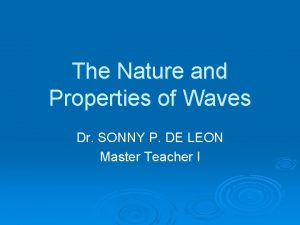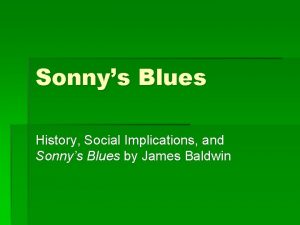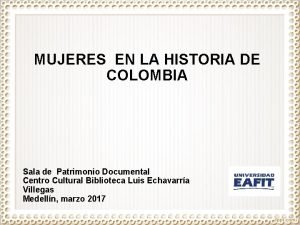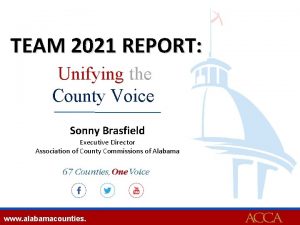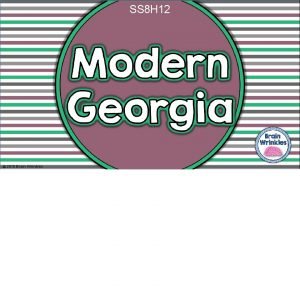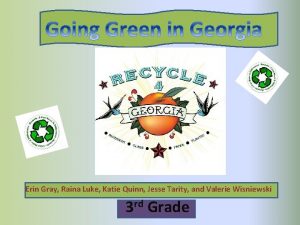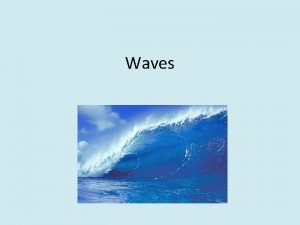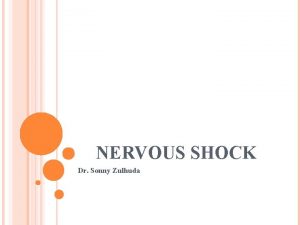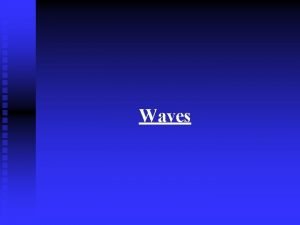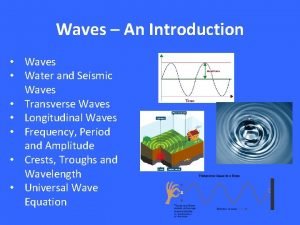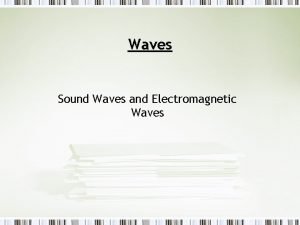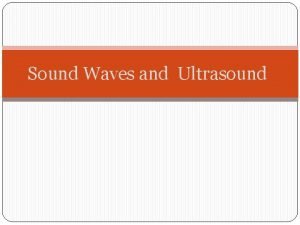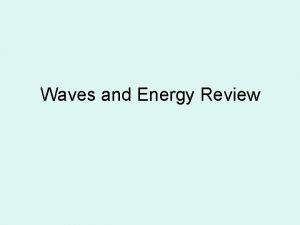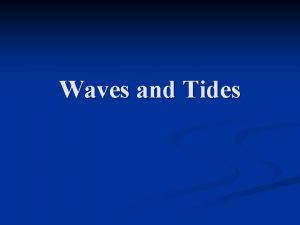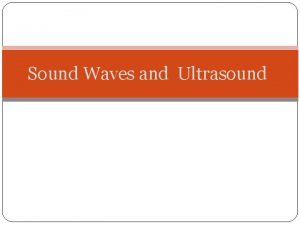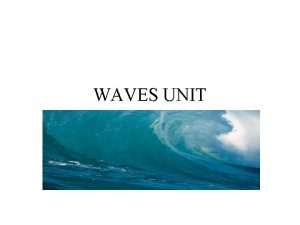The Nature and Properties of Waves Dr SONNY



























- Slides: 27

The Nature and Properties of Waves Dr. SONNY P. DE LEON Master Teacher I

Objectives Illustrate ways that the energy of waves is transferred by interaction with matter (including transverse and longitudinal/compressional waves). Ø Compare the nature and properties of transverse and compressional mechanical waves Ø Summarize characteristics of waves (including displacement, frequency, period, amplitude, wavelength, and velocity as well as the relationships among these characteristics). Ø Use the formulas v = fλ and v = d/t to solve problems related to the velocity of waves. Ø


HOTS Questions Why don't incoming ocean waves bring more water on to the shore until the beach is completely submerged? Ø In space films, we often hear the sound of the engine of the spaceship as the zoom past each other in outer space. We even hear the spaceship firing lasers at one another. What are your thoughts concerning this? Ø How will the motion of water waves change as they move from deep to shallow water? How about from shallow to deep water? Ø

Assignment: Waves Analysis 1. Identify examples of wave. 2. Compare the nature and properties of (a) transverse and longitudinal waves, (b) mechanical waves and electromagnetic waves. 3. Cite applications of different electromagnetic waves. 4. Summarize characteristics of waves (including displacement, frequency, period, amplitude, wavelength, and velocity as well as the relationships among these

What’s in a Wave? Ø Wave – a rhythmic disturbance that transfers energy through matter or space Ø Carries energy without transporting matter from place to place

Mechanical Waves Ø medium – solid, liquid, or gas that a wave travels through Ø Two types of mechanical waves: l Transverse l Compressional/ Longitudinal

Transverse Waves Ø Transverse waves – matter moves in the medium back and forth at right angles to the direction that the wave is traveling l Light waves & water waves

Compressional Waves Ø Compressional waves – matter in the medium moves back and forth in the same direction that the wave travels l Sound waves

Seismic Waves Ø Seismic waves – combination of transverse and compressional waves which carry energy along and through Earth

The Parts of a Wave Ø Crest – the highest points of a wave Ø Trough – the lowest points of a wave

Ø Compression – place in compressional wave where the particles are pushed together Ø Rarefaction – place in compressional wave where the particles are spread apart

Wavelength Ø Wavelength – the distance between one point on a wave and the nearest point just like it

Frequency and Period Ø Frequency – the number of waves that pass a given point each second Ø Measured in Hertz = 1/sec Ø Period: The amount of time it takes one wavelength to pass a point

Period and frequency relationship Ø T = period Ø f = frequency Period T= 1/f Frequency f = 1/T One hertz is equal to one peak (or cycle) per second. 1/sec

Frequency and Wavelength Ø Frequency and wavelength are inversely related l Long wavelength = Low frequency l Short wavelength = High Frequency

Wave Speed Ø The speed of a wave depends on the properties of the medium it is traveling through l l l In general sound waves travel the fastest through solids then liquids then gases Light waves travel the fastest in empty space and slowest through solids Sound waves travel faster through warmer mediums

Calculating Wave Speed Ø Speed = wavelength x frequency ØV = λ x f Ø V = velocity (m/s) Øλ = wavelength (m) Ø f = frequency (Hz; 1/sec)

Example #1 Ø What is the speed of a wave with a wavelength of 2 m and a frequency of 3 Hz? V=λxf V = (2)(3) V = 6 m/s

Example #2 Ø A wave is traveling at a speed of 12 m/s and its wavelength is 3 m. Calculate the wave’s frequency. V=λxf 12 = (3)(f) 12 = f 3 4 Hz = f

Do these on your own Ø A tuning fork has a frequency of 280 Hertz and the wavelength of the sound produced is 1. 5 meters. Calculate the velocity of the wave. Ø A wave is moving toward shore with a velocity of 5. 0 m/s. If its frequency is 2. 5 hertz, what is its wavelength?

Amplitude and Energy Ø Amplitude – the energy carried by a wave or how high the wave is; related to the amount of energy l l For compressional waves it’s the amount of compression in the wave Example: The higher the wave, the more energy (THINK on ocean waves)

l For transverse waves it’s the height of the wave

Answer the following: Ø 1. A teacher attaches a slinky to the wall and begins introducing pulses with different amplitudes. Which of the two pulses (A or B) below will travel from the hand to the wall in the least amount of time? Justify your answer.

2. The teacher then begins introducing pulses with a different wavelength. Which of the two pulses (C or D) will travel from the hand to the wall in the least amount of time ? Justify your answer.

Identify the parts of the transverse wave.

4. The water waves below are traveling along the surface of the ocean at a speed of 2. 5 m/s and splashing periodically against Wilbert's perch. Each adjacent crest is 5 meters apart. The crests splash Wilbert's feet upon reaching his perch. How much time passes between each successive drenching? Answer and explain using complete sentences.
 When sonny waves at her
When sonny waves at her Compare and contrast p waves and s waves using venn diagram
Compare and contrast p waves and s waves using venn diagram What waves do not require a medium
What waves do not require a medium Mechanical waves examples
Mechanical waves examples Similarities of mechanical waves and electromagnetic waves
Similarities of mechanical waves and electromagnetic waves Long waves and short waves
Long waves and short waves Mechanical waves and electromagnetic waves similarities
Mechanical waves and electromagnetic waves similarities Similarities of mechanical and electromagnetic waves
Similarities of mechanical and electromagnetic waves Surface waves and body waves
Surface waves and body waves Mechanical waves vs electromagnetic waves venn diagram
Mechanical waves vs electromagnetic waves venn diagram Differences between constructive and destructive waves
Differences between constructive and destructive waves Dolly parton and mick jagger
Dolly parton and mick jagger What happens when mickey mouse copyright expires
What happens when mickey mouse copyright expires Sonny's blues genre
Sonny's blues genre Sony jiménez de tejada
Sony jiménez de tejada Sonny zulhuda
Sonny zulhuda Sonny's blues short story
Sonny's blues short story Larawan na nagpapakita ng karapatan ng isang bata
Larawan na nagpapakita ng karapatan ng isang bata Sonny wrinkler
Sonny wrinkler Sonny raina
Sonny raina Light waves are electromagnetic waves true or false
Light waves are electromagnetic waves true or false What type of waves are sound waves? *
What type of waves are sound waves? * Whats a reflected sound wave
Whats a reflected sound wave Mechanical waves vs electromagnetic waves
Mechanical waves vs electromagnetic waves Is a seismic wave mechanical or electromagnetic
Is a seismic wave mechanical or electromagnetic Wave wave repeating
Wave wave repeating Nature and nature's law lay hid in night
Nature and nature's law lay hid in night Kesler science electromagnetic spectrum answer key
Kesler science electromagnetic spectrum answer key
